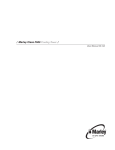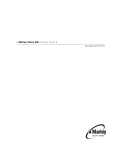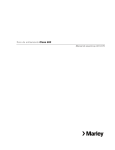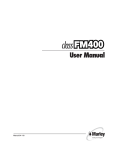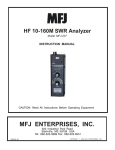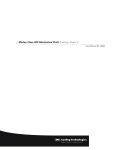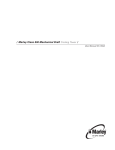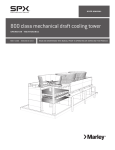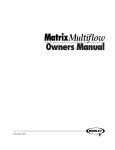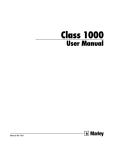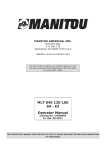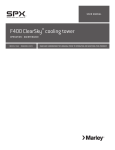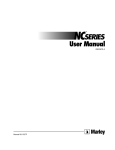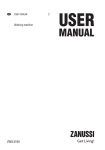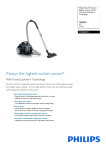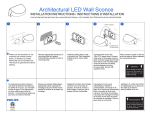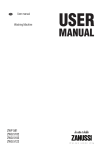Download Marley W400 Cooling Tower User Manual
Transcript
/ Marley Class W400 Cooling Tower / User Manual 92-1312D Tower Schematic FAN AIR FLOW FRP FAN CYLINDER GEAREDUCER MOTOR CORRUGATED FRP CASING INLET PVC DRIFT ELIMINATORS AIR INLET GUIDE (IF REQD) SPRAY NOZZLES PVC FILL AIR FLOW AIR FLOW ANCHORAGE CONCRETE BASIN TRANSVESE CROSS SECTION 2 Contents General...........................................................................................................................4 Before Start-up.............................................................................................................4 Initial Starting Procedure............................................................................................5 Routine Starting Procedure.......................................................................................6 Operation.......................................................................................................................6 Temperature Control and Energy Management....................................................9 Maintenance...............................................................................................................10 Cleaning......................................................................................................................12 Water Treatment........................................................................................................13 Seasonal Shutdown Instructions.......................................................................... 17 Spare Parts................................................................................................................18 Accessories................................................................................................................18 Inspection and Maintenance Schedule................................................................19 Troubleshooting.........................................................................................................20 Safety...........................................................................................................................21 Inspection Checklist.................................................................................................22 The following defined terms are used throughout this manual to bring attention to the presence of hazards of various risk levels, or to important information concerning the life of the product. Warning Indicates presence of a hazard which can cause severe personal injury, death or substantial property damage if ignored. Caution Indicates presence of a hazard which will or can cause personal injury or property damage if ignored. Note Indicates special instructions on installation, operation or maintenance which are important but not related to personal injury hazards. 3 General A cooling tower, like any heat exchanger, exchanges all heat imposed upon it from one fluid to another fluid. For a cooling tower, heat from the water is put into the air. The plant process replenishes the heat to the water, typically at another heat exchanger such as a condenser. A cooling tower differs from many heat exchangers in that heat is transferred in two forms — sensible and latent heat. As heat is transferred from the water, the air temperature increases (sensible) and the air's water content, or humidity, also increases (latent). As the heat load, inlet air wet-bulb temperature, or airflow on a cooling tower changes, the cooling tower will respond by finding a new equilibrium with the process. The cooling tower will still dissipate all the heat from the process, but at new water temperatures. The cooling tower cold water temperature is the supply water temperature to the condenser, and changes in the cold water temperature usually affect efficiency of the plant output. Although the reduced cold water temperatures that result from maximum fan power utilization are usually beneficial to plant output, the amount of fan power affects the cost of running the cooling tower. As these variables interact on a cooling tower, the operator must find the proper trade-off between these opposing forces. These instructions will assist in obtaining efficient, long life from Marley cooling equipment. Direct questions concerning tower operation and maintenance to your Marley sales office or representative. Always include your tower serial number when writing for information or ordering parts. Look for this number on the nameplate on the tower endwall access door. Before Start-up Warning Caution 4 Among other sources, outbreaks of Legionnaires’ disease have reportedly been traced to cooling towers. Maintenance procedures that prevent amplification and dissemination of Legionella and other airborne bacteria should be formulated and implemented BEFORE systems are operated and continued reqularly thereafter to avoid the risk of sickness or death SAFETY—Temporary safety barricades should be placed around any exposed openings in the operating (or non-operating) tower, safety harnesses for fall protection should be worn and used by personnel where appropriate, and other safety precautions should be taken in compliance with appropriate OSHA regulations and standards. CLEANING—New installations should be cleaned and treated with biocides by a water treatment expert before startup. Remove any dirt and trash which has accumulated in the cold water basin. Remove any sediment from the basin, sump and screens. Use a water hose to flush cold water basins. If you are restarting or recommissioning a previously used tower, see Warning note on page 12. OPERATE WATER SYSTEM—Complete steps 1 thru 4 under Initial Starting Procedure below. Circulate water over the tower continuously for several days before starting the mechanical equipment and putting the tower into continuous operation. Note Do not circulate water over the tower in freezing weather without a heat load. See caution, page 6. Initial Starting Procedure 1–Fill the cold water basin and circulating water system to a level 1/2" (13 mm) below the overflow. 2–Completely open all flow control valves in the circulating water system. 3–Prime and start the circulating water pumps one at a time. Increase the flow of circulating water gradually to design water rate to avoid surges or water hammer which could damage the distribution piping. 4–When flow has stabilized at or near the design rate, adjust water makeup to maintain the level that the water has pumped down to in the cold water basin. See Cold Water Collecting Basin on page 8. This should coincide reasonably with the recommended operating water level indicated on the Marley project drawings. 5–Start the fan. After 30 minutes operating time to permit Geareducer oil to come up to operating temperature, check motor load with watt meter, or take operating volt and ampere readings and calculate motor hp. Refer to Marley Fan User Manual for instructions. Caution If it is necessary to pitch fans to pull correct contract horsepower, measure results when circulating design water rate at design hot water temperature. Horsepower will change with air density. Lock out all electrical service before entering fan area. 5 Routine Starting Procedure After periods of routine shutdown, the following restarting procedure should be followed: 1–Start the circulating water pump(s). Increase the flow of circulating water gradually to design water rate to avoid surges or water hammer which could damage the distribution piping. Caution Circulating cold water over a tower in freezing weather will cause ice to form — which may cause damage to the fill system. Water should be bypassed until the heat load causes its temperature to rise above 70°F (21°C), at which time it may be directed over the tower. Also, towers must not be operated with reduced water rate and/or no heat load during freezing weather. If a bypass is used, do not modulate. Bypass design must be reviewed by SPX. 2–Start the fan(s). On multicell towers, only as many fans should be started as are needed to produce the desired cold water temperature. If the tower is equipped with two-speed motors, fans may be progressively started at half speed, increasing to full speed as necessary to maintain the desired cold water temperature. See Temperature Control and Energy Management, page 9. Operation TOWER PERFORMANCE—Keep the tower clean and the water distribution uniform to obtain continued maximum cooling capacity. (See Warning note, page 12.) Do not allow excessive deposits of scale or algae to build up on the fill or eliminators. Keep the nozzles free of debris to assure correct distribution and cooling of water. Uniform water distribution over the entire fill plan area is vital to the efficient operation of a film-filled cooling tower. The capacity of a tower to cool water to a given cold water temperature varies with the wet-bulb temperature and the heat load on the tower. As the wet-bulb temperature drops, the cold water temperature also drops. However, the cold water temperature does not drop as much as the wet-bulb temperature. Wetbulb temperature is the temperature indicated by the wet-bulb thermometer of a psychrometer. 6 A tower does not control the heat load. For a given heat load, the quantity of water circulated determines the cooling range. The hot and cold water temperatures increase with higher heat loads. Cooling range is the temperature difference between the hot water coming into the cooling tower and the cold water leaving the tower. FAN DRIVE—Air is caused to move through the tower by the operation of electric motor-driven fans. At full speed, these fans are designed (and pitched) to move the amount of air required to accomplish the design thermal performance. Proper utilization of these fans provides the operator a means by which to adjust the level of thermal performance to suit the requirements of the load. (See Temperature Control and Energy Management, page 9.) Caution If two-speed motors are used, allow a time delay of a minimum of 20 seconds after de-energizing the high speed winding and before energizing the low speed winding. Tremendous stresses are placed on driven machinery and motor unless the motor is allowed to slow to low speed RPM or less before the low speed winding is energized. HOT WATER DISTRIBUTION SYSTEM—Hot water from the process flows through an inlet to each cell, which supplies a distribution header and a system of branch arms and nozzles. Each distribution header pipe may be equipped with a vent standpipe to minimize water hammer, to maintain a slightly pressurized water distribution system, and to provide vacuum release at pump shutdown. Caution If an Amertap condenser tube cleaning system is part of plant equipment, care should be taken during operation to backwash the strainer section only after the sponge rubber cleaning balls are removed from the system by trapping them in the collector. Balls that are allowed to enter the cooling tower supply piping may clog some of the nozzles, although the generous flow paths through the nozzles make this unlikely. However, balls escaping the nozzles will accumulate on top of the fill ultimately causing unequal water distribution that will affect thermal performance. The top of the fill should be frequently checked until such time as the operational sequence of the Amertap system assures that no balls enter the cooling tower distribution system. FILL—Water leaving the nozzles is distributed uniformly over the fill plan area. The water flows through the fill, coating each fill sheet to maximize water surface exposure to the air being moved by the fans. ➠ 7 DRIFT ELIMINATORS—Air leaving the fill passes through a level of drift eliminators covering the entire plan area of the tower. The purpose of these drift eliminators is to minimize the amount of water that is caused to exit the tower by the velocity of the moving airstream. COLD WATER COLLECTING BASIN—Water leaving the fill falls into the cold water basin that forms the base of the tower. The normal water depth in wood, steel, or fiberglass basins is 5 to 8 inches (127 to 203 mm), while in a concrete basin, the normal water level is typically 12 inches (305 mm) below the curb. Adjust the makeup water supply to maintain this water level. Maintain sufficient water depth to prevent cavitation. WINTER OPERATION—During periods of low temperature operation, 35° to 40°F (2°C to 4°C) or below, ice will form on the relatively dry parts of the tower that are in contact with the incoming air. Primarily, this includes the air inlet and adjacent structural framing. Ice forming characteristics on any given tower will vary, depending on velocity and direction of wind, circulating water rate and heat load. Excessive ice formation may be controlled by regulating air and water flow through the tower by one or more of the following procedures: 1.Shut the fan down. This reduces the cooling rate to a minimum and increases the quantity of warm water at the air inlet to a maximum. However, normal "fan off" operation can cause reverse airflow due to the aspirating effect of the water distribution spray system. Although this reverse flow of air can be beneficial in deicing the inlet structure, it may contribute to water blowout and, therefore, must be carefully monitored. For automatic operation, a timer switch can be provided to shut the fan down for a few minutes each hour. 2.If the tower has two-speed motors, reduce the cooling rate by operating the fans at half speed forward. 3.With no heat load on the circulating water, icing cannot be controlled effectively by air control. Towers must not be operated with reduced water rate and/or no heat load during freezing weather. If a bypass directly into the cold water basin is used, all water must be bypassed so none is circulated over the tower. Design of a bypass arrangement must include consideration of water impact effect on tower components. Consult your Marley salesrepresentative. Caution 8 Reverse operation of fans is not recommended. See FAN DRIVE page 7 for fan speed change precautions. Temperature Control and Energy Management The wet bulb temperature of the ambient air varies significantly on a daily basis, and considerably from season to season. As the wet bulb temperature reduces, the tower becomes capable of producing colder and colder water — or it becomes capable of producing a given cold water temperature at reduced airflow through the tower. These characteristics are the “opposing forces” referred to under General on page 4. MAXIMIZING TOWER PERFORMANCE—If your process is one which benefits from the coldest possible water; that is, if colder water allows you to produce more product — or allows you to operate your system at significantly lower cost, then continuous full speed operation of the fan(s) may be your best mode of operation. In this mode of operation, concern for the cold water temperature level would be limited to the potential for the tower to form ice during freezing weather. (See Caution page 6, and WINTER OPERATION page 8) Although the 70°F (21°C) cold water temperature indicated on page 6 is appropriate for cold weather start-up and operation, acceptable temperatures during full operation in spring, summer and fall may be appreciably lower, perhaps as low as 50°F (10°C) or less. Refer to your performance curves for expected tower cold water temperatures at varying flow rates, ranges, and wet bulb temperatures. MINIMIZING TOWER ENERGY USE—Most processes gain no operating or production benefits from water temperatures below a certain level, and for many that level may be only 10°F to 15°F (5° to 8°C) below the design cold water temperature. When a reducing ambient wet bulb permits the tower to reach that target cold water temperature level, further reductions in the wet bulb temperature permit manipulation of fan speeds or operation to maintain that temperature level. Single speed fans can be cycled on and off for cold water temperature control, with the steps of control depending upon the number of fan cells in the tower. Two speed motors offer twice as many control steps — with the added bonus that half speed (which produces half of the normal airflow through the tower) requires less than 20% of the full speed power requirement. If your tower is equipped with a Marley Motor Control Center please refer to the appropriate User Manuals. ➠ 9 Caution Excessive fan cycling may shorten the motor's expected service life. On fans 20 feet (6 meter) diameter and smaller allow for 4 to 5 starts per hour. On larger fans, 2 or 3 starts per hour may be the limit. On two speed motors each low speed start and each high speed start count as one start. Variable frequency drives, of course, provide the ultimate in both temperature control and energy management and can be easily retrofitted to your system. Please discuss this with your Marley representative. (If your tower is equipped with a Marley VFD drive, please refer to the appropriate Owners Manual.) Unit Maintenance Warning Always shut off electrical power to the tower fan motor prior to performing any inspections that may involve physical contact with the mechanical or electrical equipment in or on the tower. Lock out and tag out any electrical switches to prevent others from turning the power back on. Service personnel must wear proper personal protective clothing and equipment. Well maintained equipment gives the best operating results and the least maintenance cost. A regular inspection schedule is recommended to insure effective, safe operation of the cooling tower. Use the schedule on page 19 to obtain continuously good performance with the least tower maintenance. See Inspection Checklist, pages 22 and 23 in this manual. Keep a continuous lubrication and maintenance record for each cooling tower. Conduct regular inspection and repair of personnel safety items (items 19 and 20 in Table on page 19). Maintaining a record of this is especially important. For a supply of check list forms, contact your Marley sales office or representative. HOT WATER DISTRIBUTION SYSTEM—Keep the circulating water and distribution system (piping and nozzles) clean and free of sand, dirt, algae, and scale. (See Caution regarding cleaning on page 12.) Algae and scale may clog nozzles, eliminators, fill, and piping, and may collect on the equipment served thus reducing its performance FILL—Clean, free-flowing, unobstructed fill is vital to the continued efficient operation and performance of a cooling tower. The owner/operator must keep the circulating water clean by treatment, screening, or filtering to avoid the possibility of fill clogging. Sea water, if used, will typically present increased clogging problems due to suspended solids and/or biological growth if the 10 water is not properly filtered and treated. The dissolved ions do not present unusual clogging problems. Contributors to the clogging of fill are trash and debris, algae, slime and scale — with the effects of scale often being worsened by the presence of suspended muds. All of these can be controlled with some combination of water treatment, screening, and filtration, and it is the owner's responsibility to institute a program of water treatment and maintenance that will minimize their impact. (See Water Treatment, page 13.) TOWER FRAMEWORK—Keep framework bolts tight. Pay particular attention to bolts in the mechanical equipment supports. Do not pull washers into the wood. DRIVE SHAFT—Check drive shaft alignment and condition of couplings every six months. See the Drive Shaft User Manual for correcting misalignment, balancing or replacing parts. ELECTRIC MOTOR—Lubricate and maintain each electric motor in accordance with the manufacturer’s instructions. If repair work is necessary, contact the nearest representative of the motor manufacturer. See Warranty Section of Marley Electric Motor User Manual. FAN—Inspect fan blade surfaces every six months. For detailed maintenance information, refer to Marley Fan User Manual. GEAREDUCER—Make weekly and monthly oil checks. Refer to the Geareducer User Manual for detailed maintenance instructions. PAINTING—Periodically clean and, if necessary, recoat any chipped or damaged paint to prevent corrosion. COLD WATER COLLECTING BASIN—Inspect collecting basin occasionally for cracks, leaks, and spalling and repair if necessary. Maintain a positive Langelier index in your circulating water. (See Water Treatment, page 13.) Minor leaks may appear in wood basins when starting with a dry basin but these generally disappear after the wood becomes soaked. Inspect steel basins for corrosion. Recoat as necessary. Keep cold water outlets clean and free of debris. Makeup and circulating water controls must operate freely and maintain the desired water quantity in the system. ➠ 11 COOLING TOWER WOOD DETERIORATION—Cooling tower wood is pressure treated to help prevent decay. However, after several years of service, some members may develop decay. Routine inspections should be made to assure that decay is discovered before it is heavily advanced. Decay is commonly of two very general types, soft rot and internal rot. Soft rot is easier to detect because it is almost always on the surface of wood members. It makes the surface soft and weak and, in its more advanced stages, the decayed wood can be easily removed. This type of rot occurs primarily in the flooded areas of the tower. Internal rot, as the name implies, occurs inside the wood members. For this reason it is more difficult to detect than is soft rot. Internal rot is most commonly found in the heavier members in the plenum areas of the tower. One of the best methods of inspection for internal rot is “sounding” with hammer blows. Members which have internal rot sound “dead” while non-rotted members have a “ring” or “live” sound. Areas which sound “dead” can be probed with a screwdriver or other pointed tool to verify the presence of internal rot. The strength of a member with soft rot is not seriously affected. However, if internal rot is discovered, the infected members should be replaced. SPX has personnel on its staff experienced in all aspects of wood deterioration and preservative treatment. In addition, several Marley publications are available which give detailed information on the subject of wood deterioration and treatment. Contact the nearest Marley sales office or representative for more information about wood inspection services and for copies of the publications. Cooling Tower Cleaning Warning Any evaporative-type cooling tower must be thoroughly cleaned on a regular basis to minimize the growth of bacteria, including Legionella Pneumophilla, to avoid the risk of sickness or death. Service personnel must wear proper personal protective equipment during decontamination. Do NOT attempt any service unless the fan motor is locked out. Operators of evaporative cooling equipment, such as water cooling towers, should follow maintenance programs which will reduce to an absolute minimum the opportunity for bacteriological contamination. Public Health Service officials have recommended that “good housekeeping” procedures be followed, such as: regular inspections for concentrations of dirt, scale, and algae; periodic flushing and cleaning; and the following of a complete water treatment program including biocidal treatment. 12 Visual inspection should take place at least once a week during the operating season. Periodic flushing and cleaning should be done at least twice a year. Nozzles, louvers, drift eliminators, and easily accessible fill surfaces should be flushed by use of a moderate-pressure water nozzle, being careful not to cause physical damage. A reliable water treatment program should be installed and maintained. Water Treatment BLOWDOWN–Blowdown, or bleed-off, is the continuous removal of a portion of the water from the circulating system. It is used to prevent dissolved solids from concentrating to the point where they will form scale. The amount of blowdown required depends upon the cooling range (design hot water temperature minus design cold water temperature) and the composition of the makeup water (water added to the system to compensate for losses by blowdown, evaporation and drift). The following table shows the minimum amount of blowdown (percent of flow) required to maintain different concentrations with various cooling ranges: COOLING RANGE Number of Concentrations 1.5X 2.0X 2.5X 3.0X 4.0X 5.0X 6.0X 5°F (2.78°C) .78 .38 .25 .18 .11 .08 .06 10°F (5.56°C) 1.58 .78 .51 .38 .25 .18 .14 15°F (8.33°C) 2.38 1.18 .78 .58 .38 .28 .22 20°F (11.11°C) 3.18 1.58 1.05 .78 .51 .38 .30 25°F (13.89°C) 3.98 1.98 1.32 .98 .64 .48 .38 Multipliers are based on drift of 0.02% of the circulating water rate. EXAMPLE: 7000 GPM (441.7 L/s) circulating rate, 18°F (10°C) cooling range. To maintain 4 concentrations, the required blowdown is 0.458% or .00458 times 7000 GPM (441.7 L/s) which is 32.1 GPM (2.02 L/s). If tower is operated at 4 concentrations, circulating water will contain four times as much dissolved solid as the makeup water, assuming none of the solids form scale or are otherwise removed from the system. Note The use of corrosion and scale inhibitors is strongly recommended. CHEMICAL TREATMENT–In some cases chemical treatment of the circulating water is not required if adequate blowdown is maintained. In most cases, however, chemical treatment is required to prevent scale formation and corrosion. Sulfuric acid or one of the polyphosphates is most generally used to control calcium carbonate scale. Various proprietary materials containing phosphates or other compounds are available for corrosion control. When ➠ 13 water treatment chemicals are required, the services of reliable water treating companies should be obtained. Caution When handling any hazardous materials, read the material safety data sheet for proper personal protective equipment and handling procedures. PREFERRED COOLING TOWER WATER CONDITION LIMITS FOR STANDARD CONSTRUCTION MATERIALS pH ----------------------------------------Maximum Water Temperature -Langelier Saturation Index--------M-Alkalinity-----------------------------Silica--------------------------------------Iron----------------------------------------Manganese----------------------------Oil and Grease-----------------------Sulfides----------------------------------Ammonia--------------------------------Chlorine---------------------------------Organic solvents---------------------Total Dissolved Solids--------------Cations: Calcium--------------------------Magnesium---------------------Sodium---------------------------Anions: Chlorides------------------------Sulfates--------------------------Nitrates--------------------------Carbonates/BicarbonatesBiological/Bacteria Film-Type Fills: MC75-----------------------------MCR 12/16---------------------Total Suspended Solids Film-Type Fill--------------------Splash-Type Fill---------------Miscellaneous Solids---------------Other nutrients------------------------GENERAL RULE: 6.5 to 9.0 120°F (48.9°C) 0.0 to 1.0 100 to 500 ppm as CaCO3 150 ppm as SiO2 3 ppm 0.1 ppm 10 ppm for splash-filled towers. None allowed for film-filled towers. 1 ppm 50 ppm if copper alloys are present. 1 ppm free residual intermittently (shock), or 0.4 ppm continuously. none allowed. over 5000 ppm can affect thermal performance and be detrimental to wood in certain areas of the tower. 800 ppm as CaCO3 depends on pH and Silica level. no limit. 750 ppm as NaCl, 455 ppm as Cl¯ 800 ppm as CaCO3 300 ppm (nutrient for bacteria). 300 ppm as CaCO3 maximum for wood. Aerobic Bacteria Plate Count: Less than 10,000 CFU/mL Less than 1,000,000 CFU/mL when TSS <25 ppm and less than 100,000 CFU/mL when TSS >25 ppm. Less than 25 ppm preferred; bacteria plate count is particularly important if TSS is above 25 ppm. No specific limit. For film fill, avoid fibrous, greasy, fatty, or tarry contamination. For film fill, avoid fats, glycols, alcohols, sugars, and phosphates. Film-type fill should not be used for certain applications in steel plants, paper mills, or food processing operations. Unless unusual water conditions have been anticipated and compensated for by the use of premium materials in the construction of the tower, then it is the owner/operator's responsibility to maintain water conditions within the 14 limits tabled above by the appropriate use of blowdown, chemical treatment, filtration, cleaning, etc. Slime, a gelatinous bacteria growth, and algae, a green or brown plant growth, may grow in the cooling tower or heat exchangers. Their presence can interfere with cooling efficiencies. Proprietary compounds are available from water treating companies for the control of slime and/or algae; however, compounds which contain copper are not recommended. The Langelier index (calcium carbonate saturation index) has proven to be an effective tool in predicting the aggressiveness of cooling tower water toward concrete. The Langelier index relates the methyl orange alkalinity; the calcium hardness; the total solids; the pH value; and the temperature of the water. From these values it is possible to calculate the index and predict the corrosive tendencies of the tower water toward concrete. An explanation and method of calculating the Langelier index can be found in all books on water treatment. Maintaining a positive Langelier index provides excellent protection of concrete. Data For Rapid Calculation of Saturation Index Saturation Index = pH(actual) - (9.3 + A + B) + (C + D) A B C D Total Solids ppm Value to Apply Water Temp ºF Value to Apply Calcium Hardness ppm Value to Apply M.O. Alkalinity ppm Value to Apply 50 - 300 400 - 1000 0.1 0.2 32 - 34 36 - 42 44 - 48 50 - 56 58 - 62 64 - 70 72 - 80 82 - 88 90 - 98 100 - 110 112 - 122 124 - 132 134 - 146 148 - 160 162 - 178 2.6 2.5 2.4 2.3 2.2 2.1 2.0 1.9 1.8 1.7 1.6 1.5 1.4 1.3 1.2 10 - 11 12 - 13 14 - 17 18 - 22 23 - 27 28 - 34 35 - 43 44 - 55 56 - 69 70 - 87 88 - 110 111 - 138 139 - 174 175 - 220 230 - 270 280 - 340 350 - 430 440 - 550 560 - 690 700 - 870 880 - 1000 0.6 0.7 0.8 0.9 1.0 1.1 1.2 1.3 1.4 1.5 1.6 1.7 1.8 1.9 2.0 2.1 2.2 2.3 2.4 2.5 2.6 10 - 11 12 - 13 14 - 17 18 - 22 23 - 27 28 - 34 35 - 43 44 - 55 56 - 69 70 - 87 88 - 110 111 - 138 139 - 174 175 - 220 230 - 270 280 - 340 350 - 430 440 - 550 560 - 690 700 - 870 880 - 1000 1.0 1.1 1.2 1.3 1.4 1.5 1.6 1.7 1.8 1.9 2.0 2.1 2.2 2.3 2.4 2.5 2.6 2.7 2.8 2.9 3.0 Based on Langelier formulas, Larson-Buswell residue, temperature adjustments and arranged by Eskel Nordell. 15 FOAMING–Heavy foaming sometimes occurs when a new tower is put into operation. This type of foaming generally subsides after a relatively short period of operation. Persistent foaming can be caused by the concentrations of certain combinations of dissolved solids or by contamination of the circulating water with foam-causing compounds. This type of foaming can sometimes be minimized by increasing the blowdown, but in some cases foam depressant chemicals must be added to the system. Foam depressants are available from a number of chemical companies. WATER DISCOLORATION—Woods contain some water-soluble substances and these commonly discolor the circulating water on a new tower. This discoloration is not harmful to any of the components in the system and can be ignored. However, a combination of foaming and discolored water can result in staining of adjacent structures if foam is picked up by air being pulled through the tower and discharged out the fan cylinders. Avoid operation of fans until the foaming is controlled. 16 Seasonal Shutdown Instructions TOWER–Drain all tower piping. During shutdown, clean the tower and make any necessary repairs. Apply protective coating as required to all metal parts. Particular attention should be given to mechanical equipment supports, drive shaft and drive shaft guards. Visually inspect for concrete deterioration. Warning See Warning note on page 12 regarding tower cleaning. MECHANICAL EQUIPMENT Shutdown for less than 3 months. Each month, drain water condensate from the lowest point of the Geareducer and its oil system. Check oil level and add oil if necessary. Operate Geareducer to recoat all interior surfaces with oil. Before start-up, drain water condensate and check oil level. Add oil if necessary. Refer to Geareducer User Manual for maintenance and lubrication instructions. Shutdown for 3 months or longer. If the motors have space heaters, operate mechanical equipment one hour each month. Space heaters should be energized anytime motor is not operating. If the motors do not have space heaters, operate mechanical equipment one hour each week. At start-up, operate mechanical equipment one hour or until oil is warm, then shut the equipment down. Drain the oil and refill with new oil. Refer to Geareducer Manual for instruction on changing oil. Refer to Marley Downtime Instruction Manual for downtime of 6 months or longer. Electric Motors Caution Do not start motor without determining that there will be no interference with free rotation of the fan drive. Refer to Marley Electric Motor Service Manual. If shutdown period is longer than seasonal, contact your Marley sales office or representative for additional information. 17 Spare Parts SPX manufactures and maintains a stock of common replacement parts for all cooling tower mechanical equipment. Shipment of these parts are normally made within ten days after an order is received. If emergency service is necessary, contact the local Marley sales office or representative for assistance. To prevent prolonged shutdown periods in case of damage to the mechanical equipment, it is suggested that the following parts be carried in the owner’s stock: • • • • One fan assembly. One Geareducer assembly. One driveshaft assembly. One motor. Be sure to furnish the tower serial number when ordering parts. Accessories Marley accessories are designed for improved maintenance access, safety, component handling, and the general customizing of the tower to suit your process. These accessories include stairways, walkways (external and internal), derricks, davits, motor control centers (page 9), as well as variable frequency drives (page 10) and other retrofittable control devices. Please discuss your needs with your Marley sales representative. 18 Inspection and Maintenance Schedule 1. I n spe ct for cloggin g D D D D 3. I n spe ct k e y s, k e y wa y s a n d se t scre ws S S S S 4. Ma k e su re v e n ts a re ope n Davits, Derricks, Hoists Fan Cylinder Casing and Louvers Structural Members Suction Screen Float Valve W S 5. L u brica te (gre a se ) Distribution System and Nozzles Cold Water Basin Fill M M 2. Ch e ck for u n u su a l n oise or v ibra tion W S R 6. Ch e ck oil se a ls M 7. Ch e ck ope ra tin g oil le v e l D 8. Ch e ck sta tic oil le v e l M 9. Ch e ck oil for wa te r a n d slu dge M 10. Ch a n ge oil S 11. Ch e ck fa n bla de tip cle a ra n ce Drift Eliminators Geareducer Drive Shaft and Guards Motor Fan More frequent inspection and maintenance may be desirable. Stairs, Ladders, Walkway, Doors, Handrails General Recommendations S 12. Ch e ck wa te r le v e l D 13. Ch e ck for le a k a ge W S S S 14. I n spe ct ge n e ra l con dition S S S S Y S Y S Y S S Y S S S 15. T igh te n loose bolts S S S S 16. Cle a n R R R R R 17. R e pa in t R R R R 18. R e ba la n ce R R 19. I n spe ct/re pa ir for sa fe u se Y Y Y R S R S R R R 20. I n spe ct a n d re pa ir be fore e a ch u se S R D – da ily ; W – we e k ly ; M – m on th ly ; Q – qu a rte rly ; S – se m i- a n n u a lly ; Y – y e a rly ; R – a s re qu ire d 19 Troubleshooting Trouble Cause Remedy Motor Will Not Start Power not available at motor terminals • Check power at starter. Correct any bad connections between the control apparatus and the motor. • Check starter contacts and control circuit. Reset overloads, close contacts, reset tripped switches or replace failed control switches. • If power is not on all leads at starter, make sure overload and short circuit devices are in proper condition. Check motor and control connections against wiring diagrams. Wrong connections Low voltage Open circuit in motor winding Motor or fan drive stuck Rotor defectve Unusual Motor Noise Motor Runs Hot Motor running single-phase Motor leads connected incorrectly Ball bearings Check lubrication. Replace bad bearings. Electrical unbalance Air gap not uniform Check voltages and currents of all three lines. Correct if required. Check and correct bracket fits or bearing. Rotor unbalance Rebalance. Cooling fan hitting guard Reinstall or replace fan. Wrong voltage or unbalanced voltage Check voltage and current of all three lines against nameplate values. Check fan blade pitch. See Fan Service Manual. Check for drag in fan drive train as from damaged bearings. Check nameplate against power supply. Check RPM of motor and gear ratio. Remove grease reliefs. Run motor up to speed to purge excessive grease. If not poor machining, replace worn bearing. Wrong motor RPM Bearings overgreased Rotor rubs stator bore Wrong lubricant in bearings Winding fault Change to proper lubricant. See motor manufacturer's instructions. Stop motor and attempt to start it. Motor will not start if singlephased. Check wiring, controls, and motor. Clean motor and check ventilation openings. Allow ample ventilation around motor. Check with Ohmmeter. Bent motor shaft Straighten or replace shaft. Insufficient grease Remove plugs and regrease bearings. Deterioration of grease, or foreign material in grease Bearings damaged Flush bearings and relubricate. Incorrect fan blade pitch See Fan Service Manual for blade pitching instructions. Voltage too low at motor terminals because of line drop Check transformer and setting of taps. Use higher voltage on transformer terminals or reduce loads. Increase wire size or reduce inertia. Look for cracks near the rings. A new rotor may be required. Have motor service person check motor. One phase open Poor ventilation Broken Rotor bars 20 Disconnect motor from load and check motor and Geareducer for cause of problem. Look for broken bars or rings. Stop motor and attempt to start it. Motor will not start if singlephased. Check wiring, controls, and motor. Check motor connections against wiring diagram on motor. Overload Motor Does Not Come Up To Speed Check nameplate voltage against power supply. Check voltage at motor terminals. Check stator windings for open circuits. Replace bearings. Troubleshooting Trouble Cause Remedy Wrong Rotation (Motor) Wrong sequence of phases Switch any two of the three motor leads. Geareducer Noise Geareducer bearings If new, see if noise disappears after one week of operation. Drain, flush, and refill Geareducer. See Geareducer Service Manual. If still noisy, replace. Replace worn or damaged gears. Gears Unusual Fan Drive Vibration Loose bolts and cap screws Tighten all bolts and cap screws on all mechanical equipment and supports. Unbalanced drive shaft or worn couplings Make sure motor and Geareducer shafts are in proper alignment and "match marks" properly matched. Repair or replace worn couplings. Rebalance drive shaft by adding or removing weights from balancing cap screws. See Drive Shaft Service Manual. Make certain all blades are as far from center of fan as safety devices permit. All blades must be pitched the same. See Fan Service Manual. Clean off deposit build-up on blades. Replace bearings as necessary. Fan Worn Geareducer bearings Unbalanced motor Loose fan hub cover Disconnect load and operate motor. If motor still vibrates, rebalance motor Check fan and pinion shaft with dial indicator. Replace if necessary. Tighten hub cover fasteners. Blade rubbing inside of fan cylinder Adjust cylinder to provide blade tip clearance. Loose bolts in blade clamps Check and tighten if necessary. Bent Geareducer shaft Fan Noise Safety The tower has been designed to provide a safe working environment while either operating or shut down. The ultimate responsibility for safety rests with the Operator and Owner. When flow to the tower is shut off or when portions of the tower require maintenance, temporary safety barricades may be required around openings. Other safety precautions such as safety harnesses, lockout/tagout, and confined space entry etc. should be utilized where appropriate for compliance with OSHA regulations and standards and good safety practices. See Warning, page 12. Routine periodic maintenance must be performed on all personnel access and material handling accessories in accordance with the following schedule: Ladders, Stairways, Walkways, Handrails, Covers, Decks, and Access Doors Davits, Derricks, and Hoists Inspect for General Condition Semi-annually Semi-annually Repair for Safe Use As Required As Required 21 Inspection Checklist Date Inspected Inspected By Owner Location Owner’s Tower Designation Tower Manufacturer Model No. Process Served by Tower Operation:Continuous q Intermittent q Seasonal q Design Conditions GPM HW °F CW Serial No. °F WB °F Number of Fan Cells Condition: 1—Good 2—Keep an eye on it 3—Needs immediate attention 1 2 3 Comments Structure Casing Material Structural Material Fan Deck Material Stairway? Ladder? Handrails? Interior Walkway? Cold Water Basin Material Material Material Material Material Water Distribution System Distribution System Header Material Manifold Material Branch Arms Nozzles—Orifice diameter inches Heat Transfer System Fill Inlet Face of Fill Eliminators Use this space to list specific items needing attention: ___________________________________________________________ ____________________________________________________________________________________________________________ ____________________________________________________________________________________________________________ ____________________________________________________________________________________________________________ ____________________________________________________________________________________________________________ ____________________________________________________________________________________________________________ ____________________________________________________________________________________________________________ 22 Inspection Checklist Condition: 1—Good 2—Keep an eye on it 3—Needs immediate attention Mechanical Equipment 1 2 3 Manufacturer Oil Level: Full Oil Condition: Good Oil Used—type Seals Back Lash Fan Shaft End Play Any Unusual Noises? q Model Add Immediately q Contains Water No q q q Yes Ratio Low, check again soon Contains Metal q q q Contains Sludge q Action Required: Drive Shafts Comments Gear Drive Units Manufacturer Material Fans q Manufacturer Fixed Pitch Diameter Number of Blades Blade Material Hub Material Hub Cover Material Blade Assembly Hardware Blade Tip Clearance Vibration Level Fan Cylinder Height Mech. Eqpt. Support Mat’l Oil Fill & Drain Lines Oil Level Sight Glass Vibration Limit Switches Other Components Motor " min. Adjustable Pitch q " max. Manufacturer Name Plate Data: hp F.L. Amps Frame Last Lubrication—Date Grease Used—Type Any Unusual Noise? No Any Unusual Vibration? No Any Unusual Heat Build-up? No RPM q q q Yes Yes Yes q q q Phase Cycle S.F. Special Info. Volts Action Required Action Required Action Required 23 7401 WEST 129 STREET | OVERLAND PARK, KANSAS 66213 UNITED STATES | 913 664 7400 | [email protected] | spxcooling.com In the interest of technological progress, all products are subject to design and/or material change without notice. ©2009 SPX Cooling Technologies, Inc. | Printed in USA Manual 92-1312D
























